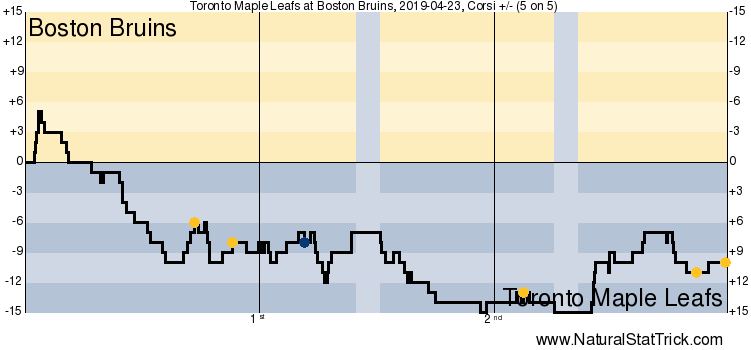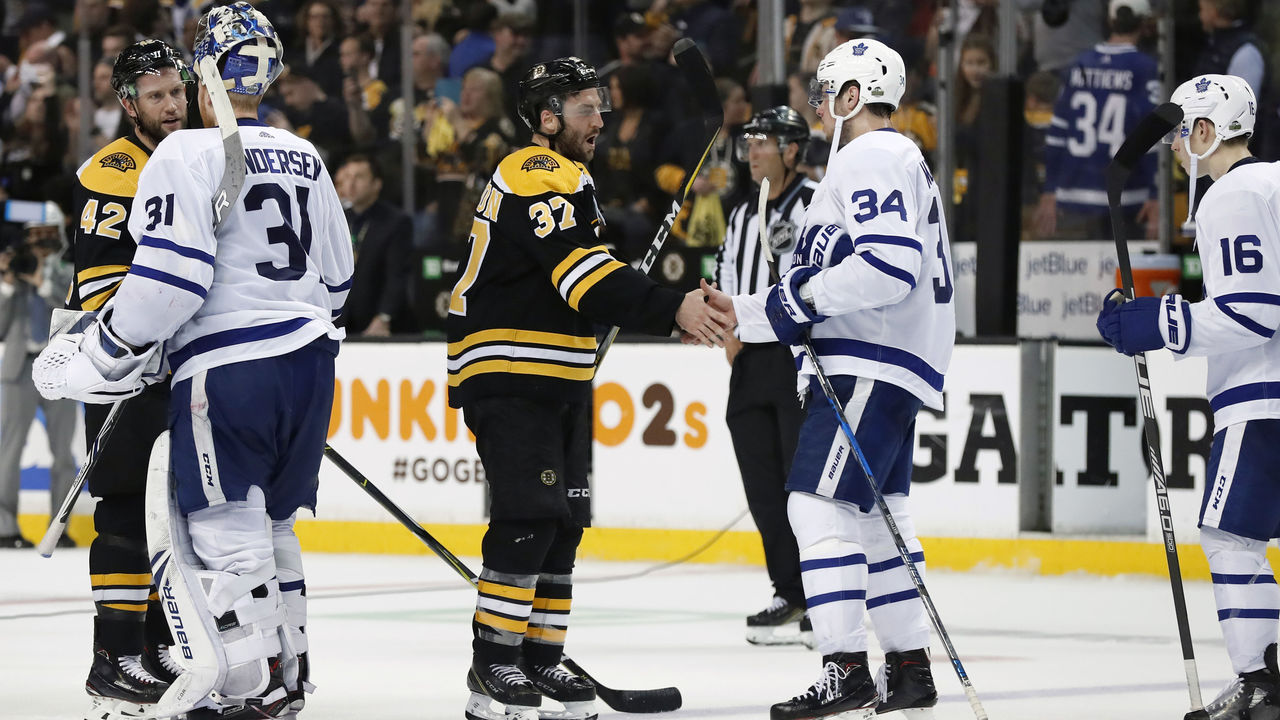Joke’s on us for expecting anything different.
Your game in ten:
1. It’s a serious case of deja vu sitting here again reflecting on yet another Game 7 heartbreak in Boston with Auston Matthews’ ice time, Nazem Kadri’s suspension, Frederik Andersen’s Game 7 play, Jake Gardiner’s Game 7 plus/minus, and Mike Babcock’s coaching decisions as the hot-button talking points. It’s hard to muster up the energy for this one tonight, but the show must go on.
2. In a lot of other respects, though, it really wasn’t deja vu. Unlike last Spring, where the Leafs were fortunate to force it to seven games based on the 3-1 series deficit and the series’ underlying numbers, the Leafs were definitely the better 5v5 team this year, and that was the case again in the first 40 minutes of Game 7 despite the 2-1 Boston lead. They led in the series three times. It was right there in their hands, with two chances to close out the Bruins, including a Game 6 at home.
3. In the 2018 series, the Leafs were out-possessed to the tune of a 47.7% Corsi For percentage and outshot to the tune of a 45.4 Shots For percentage. They were out-chanced 52/48. Their Expected Goals For percentage was 47.6.
This year? 50.8 Corsi For percentage, 48.8 Shots For Percentage, 51.5 Scoring Chances For percentage, and a 52.17 Expected Goals For percentage. We know the Leafs incorporate expected goals for in their evaluation process, and that’s a marked 4.5+ improvement by that metric.
They were a better team at 5v5 this year, and yet the result was exactly the same. The difference was they found a way to lose this series versus finding a way to hang around long enough where they could’ve — probably should’ve — won last year. A missed opportunity, to be sure.
4. There is going to be so much focus on Auston Matthews’ ice time again, but for me, on a team with two elite centers, John Tavares and Matthews averaging a shade below 20 minutes per game over the series was not the main issue in the big picture, at least not as far as 5v5 ice time goes (the power play is a different story). By comparison, they both played more than Bergeron and Pastrnak; Marner and Marchand were in similar 20+ min territory as three-situation players who play top-unit PP and PK.
What was hard to understand was how the bottom six and special teams were managed throughout the series. Nazem Kadri taking himself out of the series for the second year in a row was not Mike Babcock’s fault in the slightest, but the way he handled those two lines afterward left a lot to be desired.
Despite consistently being one of their best handful of forwards, Trevor Moore finished the series playing 7:46 on average. Babcock never really mixed Moore (or Ennis) in for a couple of shifts in a row with a top-nine center (which really should’ve happened again tonight with the spark those two were providing).
William Nylander played just about every 5v5 shift post-Kadri suspension with Patrick Marleau and Connor Brown. Nylander struggled all season coming off the contract standoff and his turnover for the 4-1 empty-netter tonight sort of summed up his season, but he was handcuffed in this series offensively by his wingers and his good games (of which there were at least three) did not yield as much as they could’ve or should’ve.
Kadri’s suspension might have taken the option of playing Nylander with Matthews regularly off the table, but it didn’t mean Babcock had to run with two clearly worse options than Ennis and Moore in Marleau and Brown all series.
5. That said, we never got to see what Babcock shortening his bench to three lines centered by Tavares, Matthews and Kadri would’ve looked like over the course of a long series, with the option of moving Kapanen down and Nylander up next to Matthews. That’s unfortunate, and a lot of that falls on Kadri not learning from his mistake from last year (that, and the five-game punishment from the DoPS was an over-the-top ruling for my money).
6. By contrast, Boston had all of their bottom six regulars above 10 minutes per night. The return of Sean Kuraly turned out to be something of an X-factor for them as he brought pace and offensive ability to their depth lines, played pretty significant minutes, and scored a huge Game 7 goal. The addition of Charlie Coyle was also a piece that — combined with Kadri’s suspension — gave them strong depth over the duration of the seven-game series. The Leafs’ depth players were outperformed in this series as it wore on; you could also argue they were outcoached by Cassidy as far as the management of the bottom six as well as opposed to Boston clearly having the better bottom-six personnel.
That said, Frederik Gauthier was the worst player on either team in this series. If Gauthier was chipping in on the PK and playing sound 200-foot hockey at 5v5 with minimal or non-existent offensive contributions, you might’ve been able to sort-of tolerate it. But he was giving the team 7-8 minutes a night with minimal to no PK time, was not used for important faceoffs, and put one shot on goal in seven games. As good of a bargain-bin signing as Tyler Ennis proved to be, Dubas and Babcock were not on the same page with the Nic Petan addition at the deadline and it gave them few options come playoff time. This falls on management as well as the coaching staff.
Overall, the Leafs’ bottom six personnel group got outscored 6-2 by Boston’s over the series and their PP got outscored 7-3. There’s your series.
7. Connor Brown and Patrick Marleau’s lack of effectiveness was something of a double whammy — in addition to providing nothing offensively at 5v5, they were relied on for key roles on the penalty kill and the power play, respectively, and were not effective there as the special teams units struggled. If you are going to get angry about Babcock not living and dying by his top guns, it’s the power play where the bulk of the focus should be directed. They never had anything approaching a functioning second power-play unit — it was often so bad that it was killing any momentum to end the PPs — and yet they played Matthews, Tavares, and Marner up to a half a minute less per game than Bergeron, Pastrnak, and Marchand.
It’s hard to know how to mete out responsibility here. The assistant coaches in charge were Jim Hiller with the PP, which under-performed for most of the year and would’ve ranked much worse if not for a blazing hot start. DJ Smith ran the PK, which finished mid-pack in the regular season and was terrible in the playoffs for the second year running. Both should certainly be under scrutiny this offseason. Babcock’s area, we can assume, is more the team’s 5v5 play. That said, the buck does stop with Babcock here and we know that two equal-ish units splitting time is very likely a Babcock preference (post-PP matchups, fresh legs likely were factoring in here as considerations).
8. Interesting remarks here:
Bruce Cassidy mentions cutting down Tuukka Rask's starts this season (45, 22nd-most in NHL) paying off: “Tonight, hopefully, we got some residual effect of that, where he was fresh the last couple games.”
— luke fox (@lukefoxjukebox) April 24, 2019
Bruce Cassidy believes the #bruins recieved the benefits of limiting Tuukka Rask's workload during the regular season tonight. That'll be a big point of interest with the #leafs and Frederik Andersen next year.
— Chris Johnston (@reporterchris) April 24, 2019
If you wanted to go with the workload point as your thesis about Frederik Andersen’s Game 7 struggles again this year — it’s not my favourite theory, but it’s a theory nonetheless — that also falls partly on management. Kyle Dubas got the backup decision wrong and it was foreseeable at the time. They let McElhinney go on waivers and Sparks ended up being a bit of a storyline for the worse — at times a distraction — and he didn’t help Babcock ease the load on Andersen in any way. It was a Cup contention year — the last of their ELC window with Matthews and Marner — and Dubas got unnecessarily cute at the backup position.
9. I’ve got no time at all for the Jake Gardiner stuff. Whether he’s coming back or not for cap reasons, he was out there playing at maybe 50% and has my respect for doing so. It was fair game last Spring to a certain extent; this season, it’s a BS scapegoat.
10. The 1-0 goal by Nordstrom came off a terrible turnover by Travis Dermott with the forwards blowing the zone looking for the stretch pass/airmail play. The Leafs, when they fell behind, returned to old habits that way for a section of the first period despite finding success with much shorter breakouts that generated speed in organized five-man units throughout most of the series. Their power play, which under-performed almost all year, again did not get the job done when it could’ve turned the game in the Leafs’ favour with the score at 2-1 in the second period (it also had a chance to start a push at 3-1 in the third).
We’ve also talked about the backup goaltending situation a lot this season, the team’s fourth line, and Babcock’s abiding belief in Marleau and Brown’s value in the lineup. All of these decisions made on margins were not only part of the reason why the Leafs ended up without home ice in this matchup in the first place (home ice plays a role here as well), many of them came home to roost in Game 7 itself despite the Leafs looking like the better overall team at 5v5.
In a league this tight and a division as tough as the Leafs’, every little detail has to be put under the microscope (this was the second year in a row the Leafs were rewarded for a 100+ point season by playing a top-five team in the first round; this year, it was a top two team with Boston tied for 2nd in the NHL at 107 points). The core pieces are in place here, make no mistake, but they’ve got to figure out how they’re going to find that extra 5-10% that they were missing in this series and the season at large. We depart the 2018-19 Toronto Maple Leafs season — the last before all of their big-money contracts kick in and some of the hard decisions really start… it was also a year in which Tampa Bay was shockingly swept in round one of the playoffs — with the distinct feeling that this was a missed opportunity.
***
Last but not least, thanks for reading along this season. Until next time.
Game Flow: 5v5 Shot Attempts

Game Highlights


![Jim Montgomery Post Game, Bruins 4 vs. Leafs 2: “[Marchand] still manages to get under people’s skin, yet he doesn’t cross the line” Jim Montgomery, Boston Bruins post game](https://mapleleafshotstove.com/wp-content/uploads/2024/04/jim-monty-pg-to-218x150.jpg)

























![Jim Montgomery Post Game, Bruins 4 vs. Leafs 2: “[Marchand] still manages to get under people’s skin, yet he doesn’t cross the line” Jim Montgomery, Boston Bruins post game](https://mapleleafshotstove.com/wp-content/uploads/2024/04/jim-monty-pg-to-100x70.jpg)







